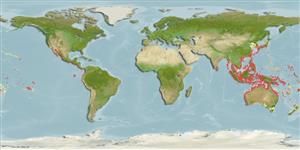Environment: milieu / climate zone / depth range / distribution range
Ecología
marino asociado a arrecife; rango de profundidad 25 - 30 m (Ref. 93839). Tropical
Western Pacific: Tokyo Bay to Taiwan and southward along the western Pacific. Reported from Samoa (Ref. 592).
Tamaño / Peso / Age
Maturity: Lm ? range ? - ? cm
Max length : 14.0 cm TL macho / no sexado; (Ref. 48635)
Espinas dorsales (total): 8; Radios blandos dorsales (total): 9; Espinas anales 2; Radios blandos anales: 8. Distinguished by having the following characteristics: dorsal fin rays VII-I, 9; anal fin rays II, 8; pectoral fin rays 14; pelvic-fin rays I, 5; pored lateral line scales 24; total gill rakers 17, developed gill rakers 12 (Ref. 93839). Further characterized by whitish body color; 6 red-brown stripes, incomplete stripes or rows of spots in between; base of caudal fin with large black spot; greatest depth of body 2.5-3.0 in SL (Ref. 90102).
Occurs along cliffs and slightly deep water (Ref. 559, 48635), in coral reef crevices (Ref. 9710). Nocturnal species (Ref. 7300). Forms small and large aggregations (Ref 90102).
Life cycle and mating behavior
Madurez | Reproducción | Puesta | Huevos | Fecundidad | Larva
Mouthbrooders (Ref. 240). Distinct pairing during courtship and spawning (Ref. 205).
Masuda, H., K. Amaoka, C. Araga, T. Uyeno and T. Yoshino, 1984. The fishes of the Japanese Archipelago. Vol. 1. Tokai University Press, Tokyo, Japan. 437 p. (text). (Ref. 559)
IUCN Red List Status (Ref. 130435)
Threat to humans
Harmless
Human uses
Más información
ReferenciasAcuiculturaPerfil de acuiculturaRazasGenéticaElectrophoresesheritabilidadEnfermedadesProcesamientoNutrientsMass conversion
Herramientas
Special reports
Download XML
Fuentes de Internet
Estimates based on models
Preferred temperature (Ref.
123201): 21.1 - 28.6, mean 27.8 °C (based on 92 cells).
Phylogenetic diversity index (Ref.
82804): PD
50 = 0.5000 [Uniqueness, from 0.5 = low to 2.0 = high].
Bayesian length-weight: a=0.00501 (0.00201 - 0.01253), b=3.26 (3.04 - 3.48), in cm total length, based on LWR estimates for this (Sub)family-body shape (Ref.
93245).
Nivel trófico (Ref.
69278): 3.5 ±0.50 se; based on food items.
Resiliencia (Ref.
120179): Alto, población duplicada en un tiempo mínimo inferior a 15 meses (Preliminary K or Fecundity.).
Fishing Vulnerability (Ref.
59153): Low vulnerability (10 of 100).
Nutrients (Ref.
124155): Calcium = 128 [69, 204] mg/100g; Iron = 0.819 [0.495, 1.340] mg/100g; Protein = 18.6 [17.5, 19.6] %; Omega3 = 0.101 [0.060, 0.175] g/100g; Selenium = 31.5 [15.7, 63.8] μg/100g; VitaminA = 85.2 [29.6, 241.9] μg/100g; Zinc = 1.76 [1.18, 2.52] mg/100g (wet weight);
